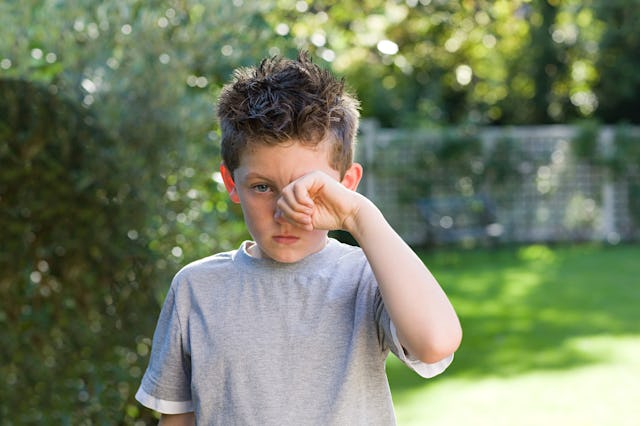Everything You (Never) Wanted to Know About Pink Eye

There are a few dreaded, yet totally common, ailments among families with young children: pinworms, lice, and, eww, pink eye. Did you just shudder? Probably. Especially if you’ve already dealt with one (or all) of these conditions in your household. They’re like the holy trinity of “Gross Childhood Things to Avoid,” right up there with mystery rashes and annoying kids shows.
Pink eye in particular is one of those things that seems almost inevitable when you have kids, unless you literally keep your children in a bubble. In fact, we applaud any family that manages to avoid pink eye because it’s so damn common. It may be nasty, but it’s basically a rite of passage. Here’s everything you (never) wanted to know about pink eye, including how to treat it fast:
What is pink eye?
Pink eye also known as conjunctivitis: an inflammation or infection of the thin, translucent membrane that covers your eyeball and lines your eyelid. It’s typically caused by a bacterial or viral infection but sometimes, it’s the result of allergies or a blocked tear duct. Basically, a person might get pink eye when they have a cold, or because they didn’t wash their hands properly after using the bathroom. Your doctor can diagnose pink eye but, honestly, you’ll likely know when you get it because your eyes will suddenly feel awful and look like they’re melting. Common conjunctivitis symptoms include redness, itchiness, a gritty feeling, watery eyes, and discharge. Fun, right?
Is pink eye contagious?
Yup — in fact, it’s really easy to spread pink eye, which is why you should deal with it right away. If one person in a classroom or household has it, chances are someone else will find themselves with symptoms as well. It’s not uncommon for conjunctivitis to spread to friends, siblings, and even parents within a matter of days. Sharing is caring! Except when it’s a nasty eye infection that no one wants.
If treated in a timely manner, pink eye is rarely harmful, but it’s definitely unpleasant and looks pretty gross. After all, who wants itchy, goopy eyes? Because pink eye spreads so easily, remind your kids to avoid touching their eyes and wash their hands frequently. Wash all of the in-use pillowcases and towels in your home, then disinfect all high-touch areas to prevent the spread of germs. Adults with pink eye symptoms should temporarily stop wearing contact lenses and throw out any mascara they’ve been using. If anyone in the family wears glasses, give them a good cleaning.
How do I get rid of pink eye?
Good news: if you and/or your kids appear to have pink eye, you can probably count on a trip to your local pharmacy. Polysporin® sells a convenient, effective bacterial pink eye treatment over the counter for around $20. It’s appropriate for ages 6 and up (ask your doctor or pharmacist before using this product on younger children).
These antibiotic eye drops are currently available without a prescription — and, Polysporin® is the #1 doctor and pharmacist-recommended anti-infection brand on the market. Polysporin® Eye and Ear Drops help eliminate the bacteria causing the infection while speeding up the healing process and providing fast relief of symptoms.
Wait — how the heck do you apply eye drops to a small child?
Have you ever wrestled an alligator, or perhaps attempted to snuggle up to a cat that isn’t fond of you? Good, then you’ve had some practice administering eye drops to small children. (We’re joking…kind of.)
Listen, if you can change a busy toddler’s diaper or get an overtired 4-year-old into a snowsuit, you can handle giving your kid some pink eye medication. It’s going to be okay. Really, you’ve got this. Here’s what to do:
- Explain what you’re doing: older kids may understand the benefit of antibiotics and participate willingly in your eye-dropping mission.
- Distract them: turn on the television, wait until your child is fully engaged in a show, then swoop in with the drops. Boom.
- Straight-up bribery: let your kids know that if they sit nicely while receiving their eye drops, they’ll get a special treat. We won’t judge!
If you’re dealing with a cooperative child or an adult, try pulling the lower eye lid below the eye lashes away from the eye to form a pouch. Squeeze one drop into the pouch, then slowly release the lower lid. Gently close the eye for one or two minutes. Do not rub the eye and try not to blink. Ta-da! Remember to always read and follow the label.
Goodbye, pink eye!
Polysporin® Ear and Eye Drops should start providing symptom relief in 1-2 days. Keep practicing good hand hygiene and washing linens, use the Polysporin Ear and Eye Drops as recommended and watch your family’s goopy eye problems get treated. And, if it happens again, make sure you have Polysporin® Ear and Eye Drops on hand. Polysporin® also offers an Antibiotic Ear Drop with Pain Relief to treat swimmer’s ear in both kids and adults — a must for any parent’s medicine cabinet.
This article was originally published on